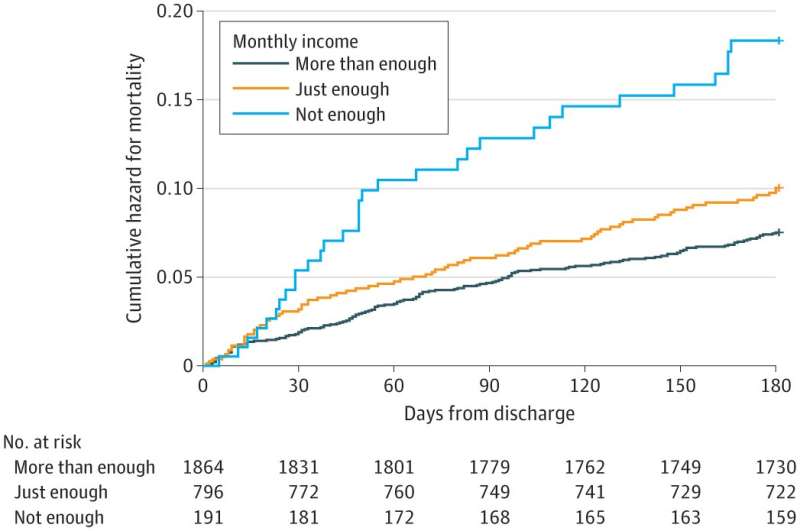In older adults, money problems increase risk of death after heart attack

Among older people who have been hospitalized for a heart attack, severe financial strain—having too little money each month to make ends meet—is associated with a 60% higher risk of dying within the six months after discharge from the hospital, according to a Yale-led study published February 22, 2022, in JAMA Internal Medicine.
"We found that severe financial strain was associated with increased risk of mortality. It's a call to the clinical world that we need to pay attention to patients' financial status," said study co-author Alexandra Hajduk, Ph.D., MPH, associate research scientist in the Department of Internal Medicine's Section of Geriatrics.
There is extensive evidence that many older people are at-risk for financial strain due to reduced income opportunities and financial losses following recent economic downturns. The study team, led by first author Jason R. Falvey, DPT, Ph.D., assistant professor of physical therapy and rehabilitation science at University of Maryland; Hajduk; Yale School of Medicine medical student Christopher Keys, JD; and Sarwat Chaudhry, MD, associate professor of medicine (general internal medicine), examined whether financial strain might also be associated with a higher risk of dying following an acute myocardial infarction (AMI), commonly known as a heart attack, among older adults.
This question and its answer are part of the larger "Comprehensive Evaluation of Risk Factors in Older Patients with AMI" or SILVER-AMI study, a cohort study led by Chaudhry that aims to improve our understanding of factors that predict health outcomes following heart attack in U.S. adults ages 75 and older.
For the present study, study coordinators at hospitals across the country asked SILVER-AMI participants, who were hospitalized with a heart attack and enrolled in the study from 2012 through 2016, whether they had more than enough money to make ends meet (defined as no financial strain), just enough (moderate financial strain), or not enough (severe financial strain). Of the patients who reported having more than enough money to pay the bills, 7.2% died within six months of leaving the hospital. Of those who reported having "just enough" money to make ends meet, 9% died within six months. Of those who reported having too little money, 16.8% died within six months. The researchers adjusted their data to account for factors beyond a recent heart attack that can influence the risk of death, such as other medical issues and conditions associated with aging. After those adjustments, the researchers found that patients who reported severe financial strain were 61% more likely than patients reporting no financial strain to die within the six months following a heart attack.
"As an epidemiologist, I am hesitant to draw any causal associations between financial strain and mortality based on this observational study. But we could certainly posit a number of mechanisms," Hajduk said. Financial strain could make it harder for patients to access transportation to their follow-up appointments and to afford co-pays for their medications, which could result in missed appointments and skipped medication doses, Hajduk said. "It could run the gamut: from not being able to fill a prescription at all, to skipping doses, which could be very dangerous for some of these drugs, to splitting doses in half to make them last longer," Hajduk said. Increased stress from money problems could also worsen health outcomes due to the effects of chronic stress on the body, she added.
Prior research has already established that poverty, defined using "absolute" measures such as being eligible for Medicaid, income is associated with poor health outcomes, Hajduk said. This study revealed a similar association between financial strain and mortality risk. "What's particularly interesting about this study is that we investigated death risk in relation to older adults' perception of their financial status, not their actual poverty level. Older adults who report financial strain- whether they have trouble making the rent on a studio apartment or covering the mortgage for a multimillion-dollar mansion- people in either of those scenarios could face financial strain such that they have trouble making their ends meet and paying for their life." Hajduk said. "I find it interesting that that this very subjective, person-specific measure of financial distress is associated with mortality after a heart attack."
The results suggest that asking older adults who are admitted to the hospital with heart attacks about their financial strain could identify patients who will be at higher risk of death following discharge, Hajduk said. Social workers could then refer patients with severe financial strain to social services to help them pay for transportation to and from follow-up appointments, prescription drug co-pays, and other medical needs. "These are things that can be coordinated at the time of hospital discharge that may improve outcomes," Hajduk said. It is less clear what can be done for patients who report severe financial strain but do not experience "absolute" poverty- a conundrum encountered in other areas of finance, such as finding ways to cover high college tuition fees when one does not qualify for need-based loans.
Chaudhry and the investigative team recently received another grant from the National Heart, Lung, and Blood Institute to link data from the SILVER-AMI study with Medicare data to continue exploring how factors such as financial strain may influence health care utilization and health outcomes following a heart attack in the longer term, Hajduk said.
More information: Jason R. Falvey et al, Association of Financial Strain With Mortality Among Older US Adults Recovering From an Acute Myocardial Infarction, JAMA Internal Medicine (2022). DOI: 10.1001/jamainternmed.2021.8569



















